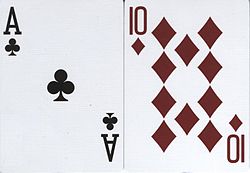Blackjack

A blackjack
|
| Alternative names |
Twenty-One |
| Players |
2+, usually 2–6 |
| Skills required |
Probability |
| Cards |
52 to 416 |
| Deck |
French |
| Play |
Clockwise |
| Random chance |
High |
Blackjack, also known as twenty-one, is the most widely played casino banking game in the world. Blackjack is a comparing card game between a player and dealer, meaning players compete against the dealer but not against other players. It is played with one or more decks of 52 cards. The objective of the game is to beat the dealer in one of the following ways:
The player or players are dealt a two-card hand and add together the value of their cards. Face cards (kings, queens, and jacks) are counted as ten points. A player and the dealer can count an ace as 1 point or 11 points. All other cards are counted as the numeric value shown on the card. After receiving their first two cards, players have the option of getting a "hit", or taking an additional card. In a given round, the player or the dealer wins by having a score of 21 or by having the higher score that is less than 21. Scoring higher than 21 (called "busting" or "going bust") results in a loss. A player may win by having any final score equal to or less than 21 if the dealer busts. If a player holds an ace valued as 11, the hand is called "soft", meaning that the player cannot go bust by taking an additional card; 11 plus the value of any other card will always be less than or equal to 21. Otherwise, the hand is "hard".
The dealer must hit until the cards total 17 or more points. (At many tables the dealer also hits on a "soft" 17, i.e. a hand containing an ace and one or more other cards totaling six.) Players win by not busting and having a total higher than the dealer's. The dealer loses by busting or having a lesser hand than the player who has not busted. If the player and dealer have the same total, this is called a "push", and the player typically does not win or lose money on that hand. If all available players bust, the hand ends automatically without the dealer having to play his or her hand.
Blackjack has many rule variations. Since the 1960s, blackjack has been a high-profile target of advantage players, particularly card counters, who track the profile of cards that have been dealt and adapt their wagers and playing strategies accordingly.
Blackjack has inspired other casino games, including Spanish 21 and pontoon.
Blackjack's precursor was twenty-one, a game of unknown origin. The first written reference is found in a book by the Spanish author Miguel de Cervantes, most famous for writing Don Quixote. Cervantes was a gambler, and the main characters of his tale "Rinconete y Cortadillo", from Novelas Ejemplares, are a couple of cheats working in Seville. They are proficient at cheating at ventiuna (Spanish for twenty-one), and state that the object of the game is to reach 21 points without going over and that the ace values 1 or 11. The game is played with the Spanish baraja deck, which lacks eights and nines. This short story was written between 1601 and 1602, implying that ventiuna was played in Castilla since the beginning of the 17th century or earlier. Later references to this game are found in France and Spain.
| Number of decks |
House advantage |
| Single deck |
0.17% |
| Double deck |
0.46% |
| Four decks |
0.60% |
| Six decks |
0.64% |
| Eight decks |
0.65% |
| Player hand |
Dealer's face-up card |
| 2 |
3 |
4 |
5 |
6 |
7 |
8 |
9 |
10 |
A |
| Hard totals (excluding pairs) |
| 17–20 |
S |
S |
S |
S |
S |
S |
S |
S |
S |
S |
| 16 |
S |
S |
S |
S |
S |
H |
H |
SU |
SU |
SU |
| 15 |
S |
S |
S |
S |
S |
H |
H |
H |
SU |
H |
| 13–14 |
S |
S |
S |
S |
S |
H |
H |
H |
H |
H |
| 12 |
H |
H |
S |
S |
S |
H |
H |
H |
H |
H |
| 11 |
Dh |
Dh |
Dh |
Dh |
Dh |
Dh |
Dh |
Dh |
Dh |
H |
| 10 |
Dh |
Dh |
Dh |
Dh |
Dh |
Dh |
Dh |
Dh |
H |
H |
| 9 |
H |
Dh |
Dh |
Dh |
Dh |
H |
H |
H |
H |
H |
| 5–8 |
H |
H |
H |
H |
H |
H |
H |
H |
H |
H |
| Soft totals |
|
2 |
3 |
4 |
5 |
6 |
7 |
8 |
9 |
10 |
A |
| A,8–A,9 |
S |
S |
S |
S |
S |
S |
S |
S |
S |
S |
| A,7 |
S |
Ds |
Ds |
Ds |
Ds |
S |
S |
H |
H |
<td style="background:lime;